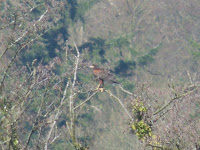Decided to have an hour looking out to sea before work and was rewarded with my first Gannet of the year(!) as well as 7 Fulmars flew west. A single Red-throated Diver flew east (as well as a Fulmar and possibly the same Gannet!) The most interesting sighting, however, were two Wagtails that flew in off, with one landing on rooftops, proving to be an adult male Grey Wagtail. I assume the other was, too.
Lunchtime had me taking pictures of 5 Waxwings in Weybourne, unfortunately the light was awful!
A brief stop at Guist on the way home produced two sky-diving Marsh Harriers, the first I have seen there this year, and also one Little Egret.












































